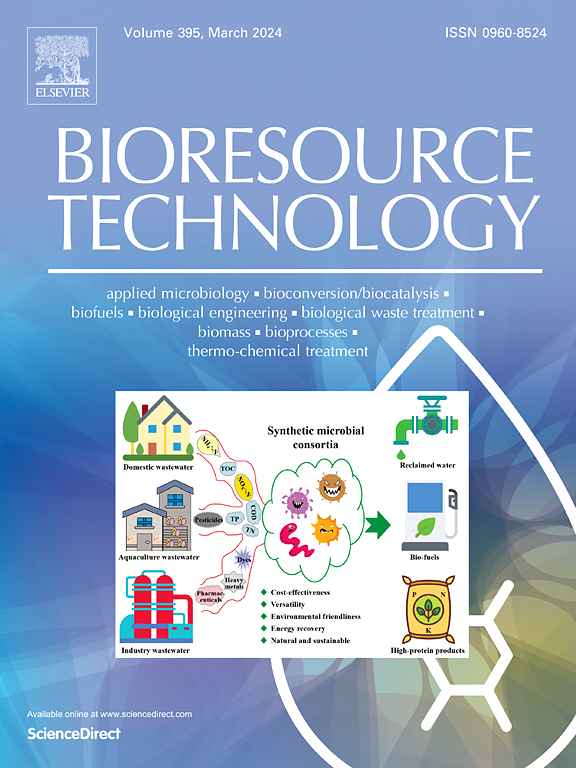Pilot-scale non-sterile mixotrophic cultivation of Galdieria sulphuraria for high-efficient removal of ammonium with enhancing high-protein biomass production from industrial effluent
IF 9
1区 环境科学与生态学
Q1 AGRICULTURAL ENGINEERING
引用次数: 0
Abstract
A complete demonstration system was established, covering non-sterile mixotrophic cultivation of G. sulphuraria for wastewater treatment from laboratory (50-L) to pilot scale (500–10,000 L) over 355 h, with spray-dried high-protein biomass production. The maximum removal rates of NH4+-N (2,170.40 mg/L/d) and PO43--P (700.40 mg/L/d) were achieved, alongside the highest productivity of biomass (30.00 g/L/d) and protein (13.51 g/L/d) in batch 2 of 10,000-L photo-fermenter. The significant decline in microbial abundance following non-sterile cultures mitigates environmental and health risks of the treated effluent. The final spray-dried powder is regarded as an ideal protein source for feed, characterized by high protein and very low levels of microbiological indicators and heavy metals. This study demonstrates the feasibility of utilizing G. sulphuraria as an efficient cell factory for NH4+-N removal from wastewater via mixotrophic cultivation, underscoring the potential of pilot-scale, non-sterile, high-protein biomass production to advance microalgae-based “waste-to-treasure” bioconversion and enable cost-effective wastewater treatment.

中试规模非无菌混合营养化培养硫酸Galdieria suuraria高效除铵并提高工业废水高蛋白生物质产量
建立了一个完整的示范体系,从实验室(50-L)到中试规模(500-10,000 L),在355 h的时间内,覆盖了非无菌混合营养培养硫酸根菌的废水处理,并喷雾干燥生产高蛋白生物质。2批10000l光发酵罐对NH4+-N (2170.40 mg/L/d)和PO43—P (700.40 mg/L/d)的去除率最高,对生物质(30.00 g/L/d)和蛋白质(13.51 g/L/d)的去除率最高。非无菌培养后微生物丰度的显著下降减轻了处理废水的环境和健康风险。最终的喷雾干粉具有蛋白质含量高、微生物指标和重金属含量极低的特点,是理想的饲料蛋白质来源。本研究证明了利用G. suluraria作为一个通过混合营养培养从废水中去除NH4+-N的高效细胞工厂的可行性,强调了中试规模、非无菌、高蛋白生物质生产的潜力,以推进基于微藻的“废物转化为宝藏”的生物转化,并使废水处理具有成本效益。
本文章由计算机程序翻译,如有差异,请以英文原文为准。
求助全文
约1分钟内获得全文
求助全文
来源期刊

Bioresource Technology
工程技术-能源与燃料
CiteScore
20.80
自引率
19.30%
发文量
2013
审稿时长
12 days
期刊介绍:
Bioresource Technology publishes original articles, review articles, case studies, and short communications covering the fundamentals, applications, and management of bioresource technology. The journal seeks to advance and disseminate knowledge across various areas related to biomass, biological waste treatment, bioenergy, biotransformations, bioresource systems analysis, and associated conversion or production technologies.
Topics include:
• Biofuels: liquid and gaseous biofuels production, modeling and economics
• Bioprocesses and bioproducts: biocatalysis and fermentations
• Biomass and feedstocks utilization: bioconversion of agro-industrial residues
• Environmental protection: biological waste treatment
• Thermochemical conversion of biomass: combustion, pyrolysis, gasification, catalysis.
 求助内容:
求助内容: 应助结果提醒方式:
应助结果提醒方式:


